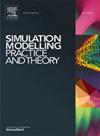Security-enabled optimal placement of drone-assisted intelligent transportation systems in mission-critical zones
IF 3.5
2区 计算机科学
Q2 COMPUTER SCIENCE, INTERDISCIPLINARY APPLICATIONS
引用次数: 0
Abstract
A massive increase in highly dynamic vehicular nodes has resulted in network instability. Owing to the heterogeneous vehicular environment requires a multi-objective solution using a meta-heuristic optimization algorithm in the event of mission-critical zones with poor signal and secured quick decision-making system. Developed a security-enabled optimal placement of Drones or unmanned aerial vehicles (UAV) in mission-critical zones aims to achieve two primary objectives: 1) Maximizing the effectiveness of the intelligent transportation system (ITS) for traffic management and ubiquitous connectivity in mission-critical zones. 2) Ensuring robust security measures to protect sensitive data and infrastructure. This approach represents a cutting-edge solution for optimizing transportation systems in high-risk environments while safeguarding against potential security threats. The pre-deployment of drones and vehicles (VOBU) parameter occurs during the registration phase, and then the mission-critical zone (MCZ) is identified and stored. The optimal position for drones in MCZs is determined by mathematically modeling a golden eagle optimization (GEO), which is inspired by varying the speed at different stages along their spiral trajectory for cruising and hunting. Furthermore, the robustness of the sensitive data and the real identity is ensured by using a biometric-based AKA algorithm utilizing the prevalent real-or-random (ROR) model and the formal security analysis. Based on a comparison of the simulation results, the proposed SDV-GEOAKA scheme outperforms the existing system- STPTC-A2 G, IoDAV, and IMOC with 99.36 % of PDR approximately, whereas, SDV-GEOAKA has maintained a load balancing factor with 0.01 to 0.1 when the transmission range between 0 and 60. When it comes to network coverage, proposed work outperforms with 99.95 % during the transmission range of 50 mW means it uses a minimum number of drones with maximum connectivity within the coverage range and also has significantly reduced the computation overhead and an increase in anomaly detection rate.
无人机辅助智能交通系统在关键任务区的安全优化布局
高动态车辆节点的大量增加导致了网络的不稳定性。由于车辆环境的异质性,在信号不佳的关键任务区和安全的快速决策系统中,需要使用元启发式优化算法的多目标解决方案。在任务关键区内开发一种支持安全的无人机或无人驾驶飞行器(UAV)优化放置方法,旨在实现两个主要目标:1) 最大限度地提高智能交通系统(ITS)在关键任务区交通管理和泛在连接方面的效率。2) 确保采取强有力的安全措施,保护敏感数据和基础设施。这种方法是在高风险环境中优化交通系统,同时防范潜在安全威胁的尖端解决方案。无人机和车辆(VOBU)的预部署参数发生在注册阶段,然后任务关键区(MCZ)被识别和存储。无人机在 MCZ 中的最佳位置是通过对金雕优化(GEO)进行数学建模确定的,其灵感来自于沿螺旋轨迹在巡航和狩猎的不同阶段改变速度。此外,利用流行的真实或随机(ROR)模型和形式安全分析,通过基于生物特征的 AKA 算法确保敏感数据和真实身份的稳健性。根据仿真结果比较,拟议的 SDV-GEOAKA 方案的 PDR 约为 99.36%,优于现有系统--STPTC-A2 G、IoDAV 和 IMOC,而当传输范围在 0 到 60 之间时,SDV-GEOAKA 保持了 0.01 到 0.1 的负载平衡系数。在网络覆盖方面,拟议的工作在 50 mW 的传输范围内以 99.95 % 的优异成绩胜出,这意味着它使用了最少数量的无人机,在覆盖范围内实现了最大的连通性,同时还显著降低了计算开销,提高了异常检测率。
本文章由计算机程序翻译,如有差异,请以英文原文为准。
求助全文
约1分钟内获得全文
求助全文
来源期刊

Simulation Modelling Practice and Theory
工程技术-计算机:跨学科应用
CiteScore
9.80
自引率
4.80%
发文量
142
审稿时长
21 days
期刊介绍:
The journal Simulation Modelling Practice and Theory provides a forum for original, high-quality papers dealing with any aspect of systems simulation and modelling.
The journal aims at being a reference and a powerful tool to all those professionally active and/or interested in the methods and applications of simulation. Submitted papers will be peer reviewed and must significantly contribute to modelling and simulation in general or use modelling and simulation in application areas.
Paper submission is solicited on:
• theoretical aspects of modelling and simulation including formal modelling, model-checking, random number generators, sensitivity analysis, variance reduction techniques, experimental design, meta-modelling, methods and algorithms for validation and verification, selection and comparison procedures etc.;
• methodology and application of modelling and simulation in any area, including computer systems, networks, real-time and embedded systems, mobile and intelligent agents, manufacturing and transportation systems, management, engineering, biomedical engineering, economics, ecology and environment, education, transaction handling, etc.;
• simulation languages and environments including those, specific to distributed computing, grid computing, high performance computers or computer networks, etc.;
• distributed and real-time simulation, simulation interoperability;
• tools for high performance computing simulation, including dedicated architectures and parallel computing.
 求助内容:
求助内容: 应助结果提醒方式:
应助结果提醒方式:


